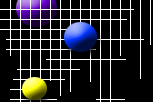

|
 |
|
The Science Behind the Biochip
|
 |
|
|
 |
|

|
| Cross Section of a Biochip |
Biochips are very intricate
and specialize in performing exceptional tasks and roles in many biological processes. A biochip is composed of
a solid substrate, no larger than a fingernail. A collection of miniaturized test sites called micro arrays are arranged
on this tiny solid substrate. They allow many tests to be performed at the same time to achieve the highest speed possible.
An array is an orderly arrangement of samples.It provides a medium for matching known and unknown DNA samples based on
base-pairing rules and "automating" the process of identifying the unknowns. Generally arrays are described as micro arrays
or macroarrays depending on their sample size. Biochips are amazing devices and hold tens of thousands
of "probes", which are segments of DNA that represent genes. A biochip is capable of performing thousands of biological reactions,
such as gene decoding, in a matter of seconds. For example, biochips were crucial in speeding up the process of
gene decoding, as a part of the world wide research effort known as the Human Genome Project. As well as being used in genetic applications, the biochip is being used in "toxicological,
medical, protein, and biochemical research". Biochips are also useful in quickly classifying and detecting chemical agents
used in biological warfare, so that defensive measures can be taken.
| Click on Picture to Learn More |

|
| Fluorescent Imaging |
|
 |
|
|
 |
|
|
 |
|
|
 |
 |
 |
|
| How Biochips Work : Outline |

|
| A Biochip Arrayer |

|
| This device is one of many devices that uses a laser to test and analyze biochips |
How Do They Work?
So we know that a biochip is small and intricate
but how do they work? First, messenger RNA, a molecule that carries the code of a gene so a protein can be made, is extracted
from the cell and labelled with fluorescent tags. Next a variety of active genes provide a mixture of RNA, which is then
placed on the micro array slide. The mixture of RNA is then covered with small peices of genes. Each gene type has its
own location on the slide.
The RNA, which was labelled with a fluorescent tag, then clings
to the DNA fragments with the genetic coding that is complimentary to that of the RNA. RNA from gene A binds with
the DNA fragments of gene A, RNA from gene B binds with DNA fragments from gene B, and so on. Then the brightness of each
spot can be determined by scanning the slide. In this way, the researcher can determine not only which genes are not active
in the cell, but get a rough idea of how much protein is being produced by each of the genes that is active.
Affymetrix Santa Clara, Calif., Developed a similar
procedure, in which genetic sequences are synthesized on a silicon chip. This technology is very similar to that in the
production of the well known Computer Chip. This biochip also relies on fluorescence to determine which
genes are active.
When it comes to biochips there are different types and forms. These forms tend to work using principles and procedures that differ slightly from eachother.
| A DNA- Array Biochip |

|
| The coloured lights signify the activation of the biochip,active & dormant genes will be identified |
|
|

